Was ist Generative KI? Definition, Besonderheiten und Einsatzbereiche
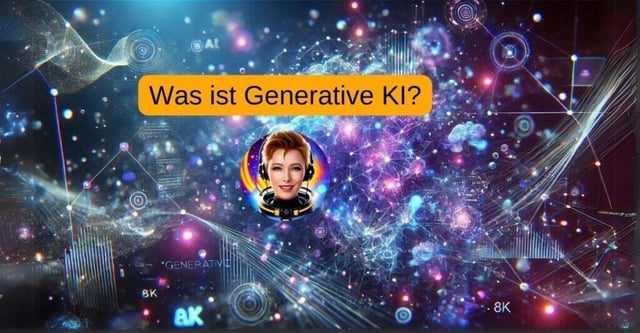
Transformator-Modelle bilden das Herzstück moderner generativer KI-Systeme und revolutionieren die Verarbeitung und Erzeugung von Inhalten wie Text, Bild und Audio. Durch ihre Fähigkeit, komplexe Muster zu erkennen und Kontext zu verstehen, ermöglichen sie die Entwicklung leistungsfähiger und anpassungsfähiger KI-Anwendungen, die in verschiedenen Bereichen von der Textgenerierung bis zur wissenschaftlichen Forschung eingesetzt werden.
Definition und Fähigkeiten der Generativen KI
.webp?width=640&height=568&name=aiforeducation_io+(1).webp)
Bildquelle: aiforeducation.io
Künstliche Intelligenz, die auf Basis von Vorgaben und vorhandenen Informationen neue Inhalte erzeugen kann, wird als Generative AI bezeichnet. Diese innovative Technologie nutzt fortschrittliche Deep-Learning-Modelle und KI-Algorithmen, um eine Vielzahl von Inhalten zu generieren, darunter Texte, Bilder, Audio, Video und sogar Programmcode.
Durch das Training mit großen Datenmengen erkennen diese Systeme komplexe Muster und Beziehungen, die es ihnen ermöglichen, auf Benutzereingaben mit relevanten und originellen Ausgaben zu reagieren. Die Fähigkeit, menschenähnliche Inhalte zu produzieren und kreative Aufgaben zu bewältigen, macht Generative AI zu einem leistungsstarken Werkzeug in verschiedenen Bereichen, von der Contentproduktion bis hin zur wissenschaftlichen Forschung.
Technologische Grundlagen der Generativen KI
Die technologische Basis der Generativen KI umfasst mehrere fortschrittliche Modelle und Architekturen. Transformator-Modelle, die häufig für Sprachverarbeitung und Textgenerierung eingesetzt werden, bilden das Rückgrat vieler generativer KI-Systeme.
Large Language Models (LLMs) sind speziell für die Verarbeitung natürlicher Sprache entwickelt und ermöglichen komplexe Sprachaufgaben. Für die Bildgenerierung kommen oft Generative Adversarial Networks (GANs) und Diffusionsmodelle zum Einsatz. Diese Technologien zeichnen sich durch ihre Skalierbarkeit, Anpassungsfähigkeit und die Fähigkeit zur Verarbeitung riesiger Datenmengen aus, was die Erkennung komplexer Muster und die Erzeugung völlig neuer, origineller Inhalte ermöglicht.
Anwendungsbereiche der Generativen KI
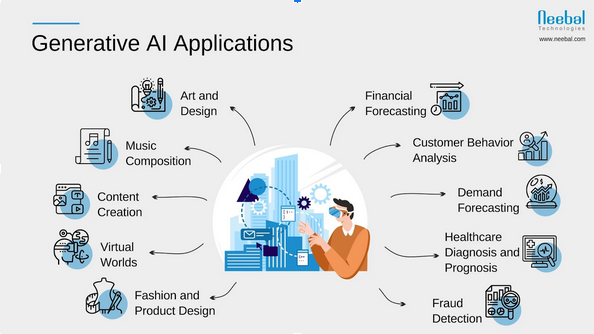
Quelle: jaroeducation.com
Generative KI findet vielfältige Anwendung in verschiedenen Bereichen. In der Textgenerierung unterstützt sie bei der Erstellung von Studienarbeiten, Fachartikeln, Werbetexten und sogar Gedichten. Bildgenerierungstools wie DALL-E und Midjourney revolutionieren die visuelle Contentproduktion, während im Audiobereich ganze Lieder kreiert werden können.
Videogenerierungssysteme wie Pictory und HeyGen eröffnen neue Möglichkeiten in der Videoproduktion. In der wissenschaftlichen Forschung unterstützt generative KI bei der Entwicklung neuer Medikamente, während sie in der Produktentwicklung und im Design zur Visualisierung kreativer Ideen eingesetzt wird. Diese breite Palette an Anwendungen unterstreicht das transformative Potenzial der Technologie in kreativen und analytischen Prozessen.
Herausforderungen und Kritik an Generativer KI
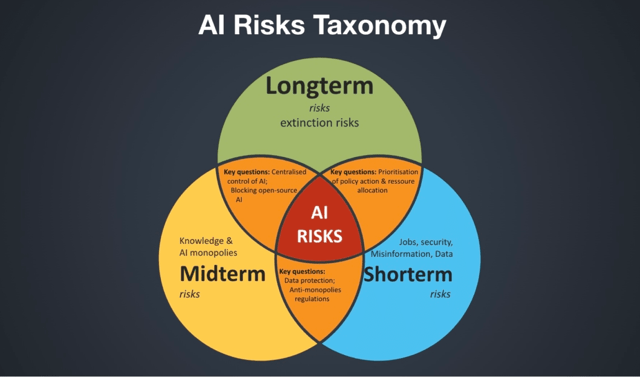
Quelle: https://www.diplomacy.edu/blog/how-can-we-deal-with-ai-risks/
Trotz ihres immensen Potenzials steht die generative KI vor erheblichen Herausforderungen. Ein zentrales Problem sind sogenannte „Halluzinationen“, bei denen unrichtige oder unrealistische Inhalte erzeugt werden. Ethische Bedenken entstehen durch die mögliche Verletzung von Personen durch generierte Inhalte, während Urheberrechtsfragen bezüglich Datenquellen und Datenschutzbedenken hinsichtlich der informationellen Autonomie der Benutzer diskutiert werden.
Zudem besteht eine Dual-Use-Problematik, da die Technologie potenziell für schädliche Zwecke missbraucht werden könnte. Diese Herausforderungen unterstreichen die Notwendigkeit einer sorgfältigen Betrachtung und verantwortungsvollen Nutzung generativer KI-Systeme.
Besonderheiten der Generativen KI
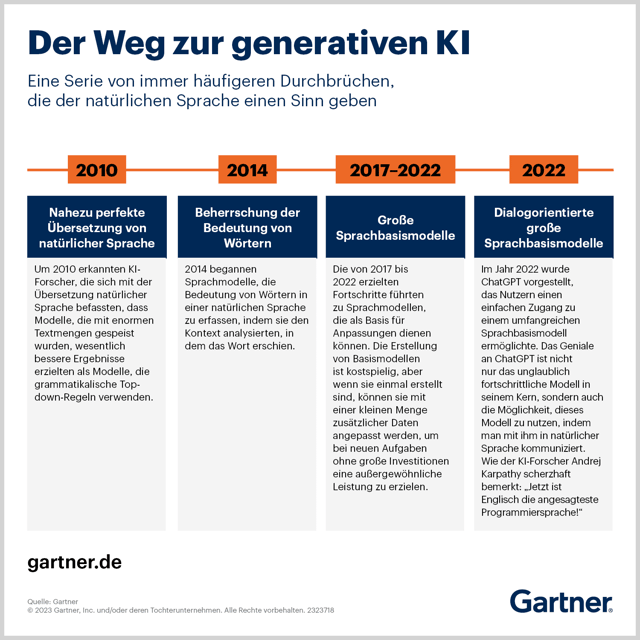
Quelle: gartner.de
Generative KI zeichnet sich durch ihre einzigartige Fähigkeit aus, neue Dateninstanzen zu erzeugen, die die Eigenschaften der Eingabedaten nachahmen. Im Gegensatz zur traditionellen KI, die sich auf die Analyse und Vorhersage spezifischer Aufgaben konzentriert, geht generative KI einen Schritt weiter und schafft völlig neue Inhalte. Diese Besonderheit ermöglicht vielfältige Anwendungen, von der Erstellung virtueller Assistenten mit menschenähnlichen Reaktionen bis hin zur Generierung synthetischer Daten für das Training anderer KI-Modelle.
Der Grundpfeiler der generativen KI ist das Deep Learning, das es den Modellen ermöglicht, komplexe Muster in großen Datensätzen zu erkennen und daraus zu lernen. Dieser Ansatz verleiht generativer KI eine bemerkenswerte Anpassungsfähigkeit und Kreativität, die sie von regelbasierten Systemen der klassischen KI unterscheidet. Durch diese Fähigkeiten kann generative KI Innovationen vorantreiben, kreative Aufgaben automatisieren und personalisierte Kundenerlebnisse schaffen, was sie zu einem leistungsstarken Werkzeug für Unternehmen macht.
Unterschiede: Traditionelle und Generative KI
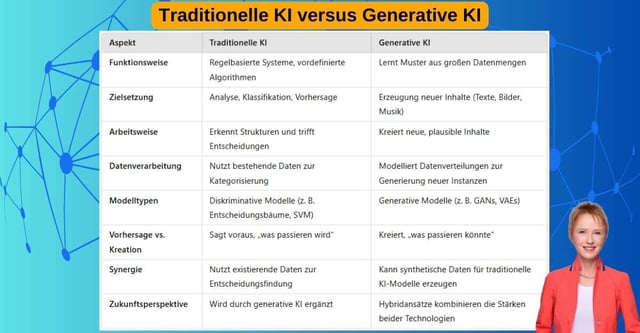
Quelle: Hilker-Consulting.de
Generative KI unterscheidet sich fundamental von klassischer KI durch ihre Fähigkeit, neue Inhalte zu erschaffen, anstatt nur bestehende Daten zu analysieren. Während traditionelle KI-Systeme auf Mustererkennung, Klassifikation und Vorhersagen spezialisiert sind, kann generative KI kreativ tätig werden und originelle Texte, Bilder, Musik oder Programmcode erzeugen. Dieser Unterschied eröffnet neue Anwendungsfelder wie automatisiertes Design, Content-Erstellung und innovative Problemlösungen.
Klassische KI-Modelle arbeiten oft mit expliziten Regeln und vordefinierten Algorithmen, wohingegen generative KI tiefgehende Lernalgorithmen wie GANs und VAEs nutzt, um komplexe Muster in großen Datensätzen zu erkennen und daraus zu lernen. Dies ermöglicht es generativer KI, flexibler und adaptiver auf neue Situationen zu reagieren und Inhalte zu produzieren, die den Trainingsdaten ähneln, ohne sie exakt zu replizieren32. Trotz dieser Unterschiede ergänzen sich beide Ansätze in vielen Anwendungsbereichen und tragen gemeinsam zu Innovationen in der KI-Technologie bei5.
Einsatzbereiche: Generative und Klassische KI
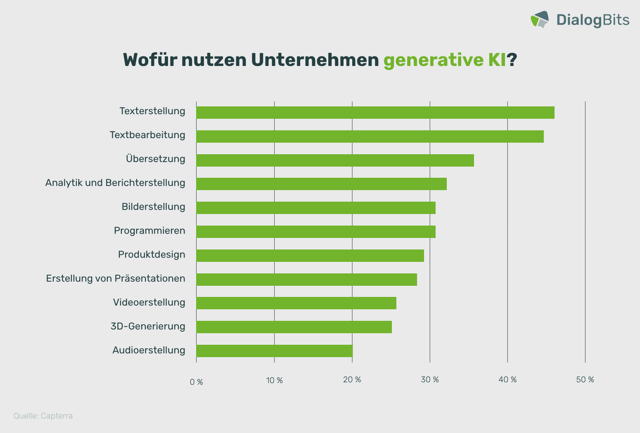
Quelle: dialogbits.com
Generative KI und klassische KI haben unterschiedliche Stärken und Einsatzbereiche:
- Generative KI: Eignet sich besonders für kreative Aufgaben wie Texterstellung, Bildgenerierung und Musikkomposition. Sie wird auch in der Produktentwicklung, im Kundenservice und im Content-Marketing eingesetzt. In der Wissenschaft unterstützt sie bei der Entwicklung neuer Medikamente und der Erzeugung synthetischer Daten für Forschungszwecke.
- Klassische KI: Findet Anwendung in der Prozessautomatisierung, Datenanalyse und Entscheidungsfindung. Sie wird häufig für spezifische, klar definierte Aufgaben wie Bildklassifizierung oder Vorhersagemodelle eingesetzt.
Während generative KI neue Inhalte erschafft, konzentriert sich klassische KI auf die Analyse und Interpretation vorhandener Daten. In der Praxis ergänzen sich beide Ansätze oft, um innovative Lösungen in verschiedenen Branchen zu entwickeln.
Investitionen in Generative KI explodieren
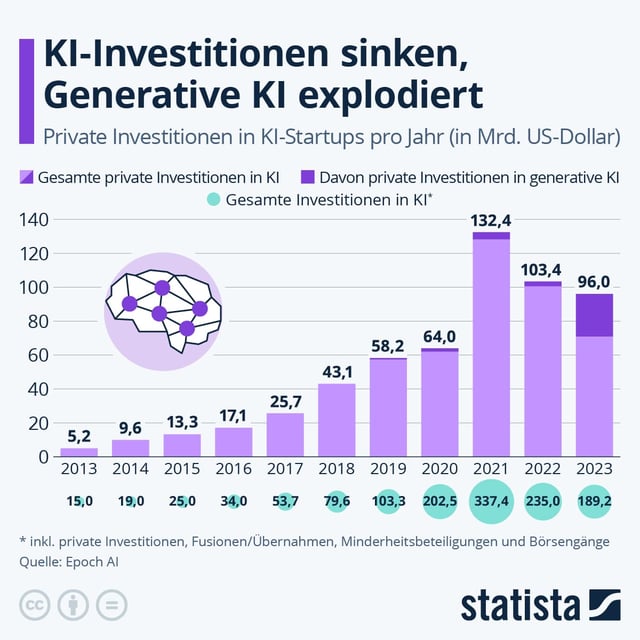
Quelle: Statista
Die Investitionen in KI-Startups haben in den letzten Jahren einen bemerkenswerten Anstieg erfahren, was das wachsende Interesse und Vertrauen in generative KI-Technologien widerspiegelt. Laut einer Statistik stiegen die privaten Investitionen in KI-Startups von 3,3 Milliarden US-Dollar im Jahr 2013 auf einen Höchststand von 69,6 Milliarden US-Dollar im Jahr 2021.
Dieser massive Zuwachs unterstreicht die Bedeutung, die Investoren und Unternehmen der generativen KI beimessen, insbesondere in Bereichen wie Textgenerierung, Bildverarbeitung und prädiktive Analysen.Trotz eines leichten Rückgangs auf 45,8 Milliarden US-Dollar im Jahr 2022 bleibt das Investitionsvolumen im Vergleich zu früheren Jahren beachtlich hoch.
Dieser Trend deutet darauf hin, dass generative KI-Technologien weiterhin als vielversprechende Innovationstreiber angesehen werden, die das Potenzial haben, verschiedene Branchen zu transformieren und neue Geschäftsmöglichkeiten zu eröffnen. Die anhaltenden Investitionen fördern die Weiterentwicklung und Verfeinerung generativer KI-Modelle, was wiederum zu verbesserten Fähigkeiten und breiteren Anwendungsmöglichkeiten in der Zukunft führen dürfte.
Zukunftsperspektiven der Generativen KI
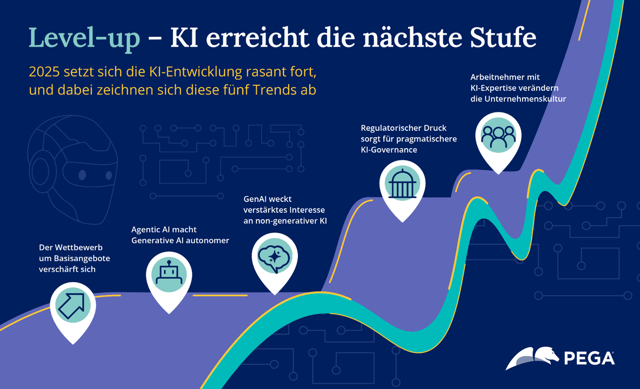
Quelle: news.it-matchmaker
Die Zukunft der generativen KI verspricht bahnbrechende Entwicklungen und weitreichende Auswirkungen auf verschiedene Branchen. Bis 2025 werden voraussichtlich mehr als 30% neuer Medikamente und Materialien systematisch mit generativen KI-Techniken entdeckt, was die Effizienz in der Pharma- und Materialforschung erheblich steigern wird.
Ein zentraler Trend ist die Entwicklung von agentenbasierter KI, die generative Modelle autonomer und zielorientierter macht. Diese Agenten können komplexe Aufgaben selbstständig interpretieren und ausführen, was zu einer tieferen Integration von KI in Geschäftsprozesse führt. Parallel dazu wird erwartet, dass sich der Fokus von reiner Innovationsbegeisterung hin zu messbaren geschäftlichen Ergebnissen verlagert, wobei generative KI zunehmend in personalisierte Kundeninteraktionen und operative Abläufe eingebettet wird.
Du brauchst KI-Beratung, Training oder Coaching?
Nutze die Chancen der Künstlichen Intelligenz! Lass uns gemeinsam deine Ziele erreichen. Buche noch heute einen Termin für eine individuelle Beratung oder ein maßgeschneidertes Training.
👉 Jetzt Termin buchen und starten du Ihre Reise in die Welt der KI!
